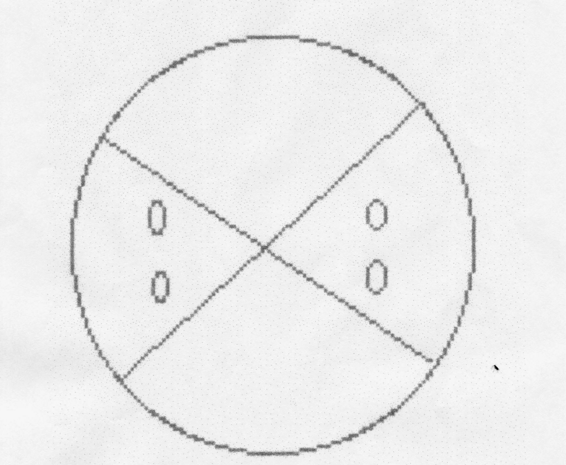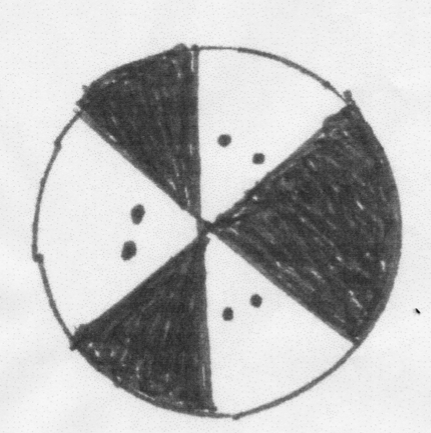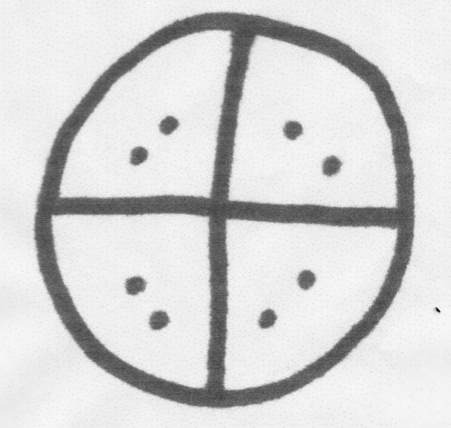"Droodle Me This ... ": Pictorial Declarations and the American Dream Maria Teresa Agozzino
With-drawing the American Nightmare
According to the Declaration of Independence: "All Men are created equal, that they are endowed by their Creator with certain unalienable Rights, [and] that among these are Life, Liberty, and the Pursuit of Happiness" (Cullen 38). In a multicultural society, these lofty yet intangible foundational ideals are as negotiable as they are exclusive. Though women, many immigrant groups, and Native Americans were omitted in the 'Creator's plans, undoubtedly a grave collective cultural scar was scored by the treatment of enslaved peoples forced to enter the United States. I do not need to recount the historical record; you can see it for yourself.  The following cycle assumes knowledge of United States history and accentuates the longevity of cultural memory in black and white. Drawn in as little as three seconds, a circle, two straight lines, and an optional four dots, instantly signify almost three hundreds years of American history. Versions of the given example portray anywhere from two to six hoods (see Figures 8, 9, and 10).
The following cycle assumes knowledge of United States history and accentuates the longevity of cultural memory in black and white. Drawn in as little as three seconds, a circle, two straight lines, and an optional four dots, instantly signify almost three hundreds years of American history. Versions of the given example portray anywhere from two to six hoods (see Figures 8, 9, and 10).
Figure 8: "Two KKK Members Looking Down a Well," [22] or "Two Members of KKK Looking Down the Sewer Hole After Throwing a Nigger Into It." [23]
In these versions, as in Figure 7, the agency resides with Klan members. They are the subjects, the actors, in the droodle, whether or not a victim is spelled out. [24] The droodle design plays on a perception of depth; the responder is required to literally look down into the well (or hole) mirroring the Klan's metaphorical (and physical) looking down on its victim.
The majority of captions, however, revolve around the a black man's view from the bottom of a well:  "The last thing a nigger sees when the Ku Klux Klan throws him down a well," [25] or " [...] down a man hole;" [26] "The last thing a nigger sees after the Klan throws him into a well;" [27] "A nigger looking up from the well he's just been thrown into by four Ku Klux Klan members;" [28] "A Black man looking up the well at the three KKK members who threw him in;" [29] "The last thing a nigger sees before he's dead;" [30] or "[...] before he gets killed;" [31] and "What a black man in the South sees when he wakes up in the morning at the bottom of a well." [32]
"The last thing a nigger sees when the Ku Klux Klan throws him down a well," [25] or " [...] down a man hole;" [26] "The last thing a nigger sees after the Klan throws him into a well;" [27] "A nigger looking up from the well he's just been thrown into by four Ku Klux Klan members;" [28] "A Black man looking up the well at the three KKK members who threw him in;" [29] "The last thing a nigger sees before he's dead;" [30] or "[...] before he gets killed;" [31] and "What a black man in the South sees when he wakes up in the morning at the bottom of a well." [32]
Figure 9: "KKK Members Looking Down a Well"
The black man becomes the subject of the droodle, and reveals that his view of the world is from the bottom up. He is literally cast down by 'upstanding' citizens. The evolution of the agency as portrayed in droodles mirrors the advancement of African Americans in society. Though informants agree that they would not show any of these texts to African American friends, the shift to more politically correct titles reflects an increase in both sensitivity and ignorance: "It's the last thing a nigger sees as he's falling down a well," [33] and "It's the last thing an ethnic minority sees when being thrown down a well by the Ku Klux Klan." [34]  The performance and production of these droodles is framed by time and place; limits are context driven and acceptability related to the perceived sensitivity of the audience (Goffman 50). Indeed, neutral and contemporaneous guesses include, "Sharks looking down a hole," [35] "A half-eaten anchovy pizza," "Rats playing poker," [36] and "The world viewed [sometimes by a mouse] from the inside of a beer can." [37]
The performance and production of these droodles is framed by time and place; limits are context driven and acceptability related to the perceived sensitivity of the audience (Goffman 50). Indeed, neutral and contemporaneous guesses include, "Sharks looking down a hole," [35] "A half-eaten anchovy pizza," "Rats playing poker," [36] and "The world viewed [sometimes by a mouse] from the inside of a beer can." [37]
Figure 10: "KKK Members Looking Down a Well"
Maria Teresa Agozzino has a Ph.D. in Folklore and Celtic Studies from the University of California, Berkeley, where she served as Head Reader for Alan Dundes from 1999-2004 and as Head Archivist from 2000 to 2004. She has taught folklore and American Studies courses at UC Berkeley and California State University, East Bay. Her publications include "Welsh Calennig and Greek Kalanda: Begging in the New Year," Cosmo: The Journal for the Traditional Cosmology Society 19 (2005): 21-45, "Ysbryd y Werin: An Overview of Celtic Folklore Scholarship," The Folklore Historian 22 (2005): 13-33, and "First Come, First Served: Investigating Sir John Rhys' 'Essential Connexion' between Celtic New Year Customs." Studi Celtici: An International Journal of History, Linguistics, and Cultural Anthropology 2 (2003). This paper evolved from a guest lecture presented to an introductory American Studies course at UC Berkeley in fall 2005. She is much obliged to Christine Palmer for the opportunity.
